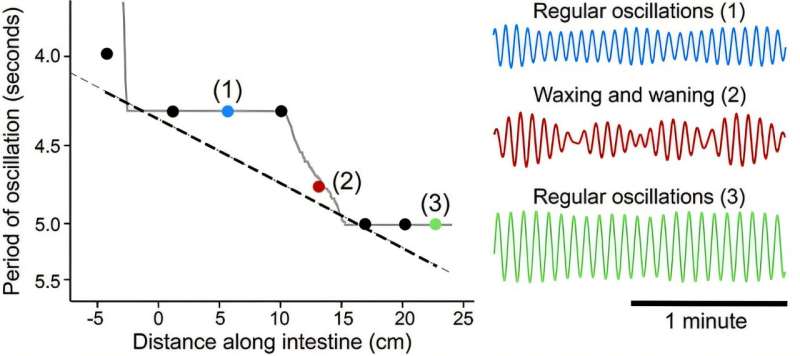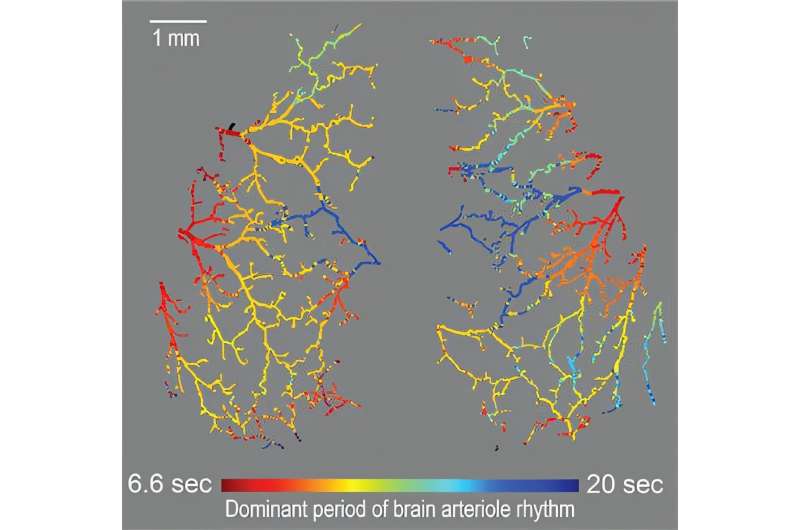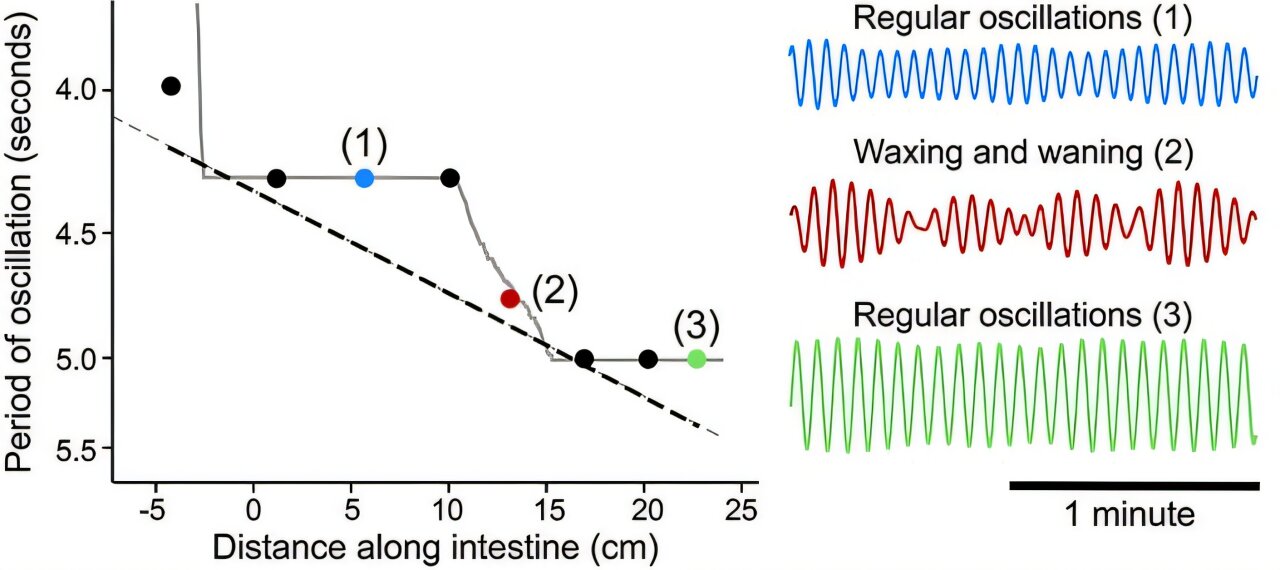
Comparison between experimental peristalsis and the modeling data. (Left) Circles are the period of oscillations recorded in the intact intestine, while the grey staircase is obtained from the model. (Right) The structure of three time courses of the oscillations. Credit: University of California – San Diego
Synchronization abounds in nature: from the flashing lights of fireflies to the movement of fish wriggling through the ocean, biological systems are often in rhythmic movement with each other. The mechanics of how this synchronization happens are complex.
For instance, in the vasculature of the brain, blood vessels oscillate, expanding and contracting as needed. When there is neural activity, the arterioles expand to increase blood flow, oxygen and nutrients. These oscillations are self-sustained, but the arterioles also work in concert with each other. How this happens is not well understood.
To uncover the answer, researchers at the University of California San Diego looked to another part of the body: the gut. Here they found that oscillators operating at similar frequencies lock onto each other in succession, creating a staircase effect. Their work appears in Physical Review Letters.
Biology in sync
It is known in the scientific community that if you have a self-sustained oscillation, such as an arteriole, and you add an external stimulus at a similar but not identical frequency, you can lock the two, meaning you can shift the frequency of the oscillator to that of the external stimulus. In fact, it has been shown that if you connect two clocks, they will eventually synchronize their ticking.
Distinguished Professor of Physics and Neurobiology David Kleinfeld found that if he applied an external stimulus to a neuron, the entire vasculature would lock at the same frequency. However, if he stimulated two sets of neurons at two different frequencies, something unexpected happened: some arterioles would lock at one frequency and others would lock at another frequency, forming a staircase effect.
Searching for an explanation, Kleinfeld enlisted the help of his colleague, Professor of Physics Massimo Vergassola, who specializes in understanding the physics of living systems, and then recruited Ecole Normale Supérieure graduate student Marie Sellier-Prono and Senior Researcher at the Institute for Complex Systems Massimo Cencini. Together, the researchers found they could use a classical model of coupled oscillators with an intestinal twist.

Credit: University of California – San Diego
The gut oscillates naturally due to peristalsis—the contracting and relaxing of muscles in the digestive tract—and provided a simplified model over the complex network of blood vessels in the brain. The intestine is unidirectional, meaning frequencies shift in one direction in a gradient from higher to lower. This is what enables food to move in one direction from the beginning of the small intestine to the end of the large intestine.
“Coupled oscillators talk to each other and each section of the intestine is an oscillator that talks to the other sections near it,” stated Vergassola. “Normally, coupled oscillators are studied in a homogeneous setting, meaning all the oscillators are at more or less similar frequencies. In our case, the oscillators were more varied, just as in the intestine and the brain.”
In studying the coupled oscillators in the gut, past researchers observed that there is indeed a staircase effect where similar frequencies lock onto those around it, allowing for the rhythmic movement of food through the digestive tract. But the height of the rises or breaks, the length of the stair runs or frequencies, and the conditions under which the staircase phenomenon occurred—essential features of biological systems—was something which had not been determined until now.
Discover the latest in science, tech, and space with over 100,000 subscribers who rely on Phys.org for daily insights.
Sign up for our free newsletter and get updates on breakthroughs,
innovations, and research that matter—daily or weekly.
This new mathematical solution answers two longstanding biological questions at the same time: how food moves through the digestive tract and how it is churned. The team hopes this work will support further research into peristalsis-related digestive health issues known as gastrointestinal motility disorders.
“The mathematics had been solved in an approximate way before now, but not in a way that gave you these breaks and what happens at the breaks. That’s a critical discovery,” stated Kleinfeld.
Now that they’ve solved the question of oscillations in the gut, they’re back to studying the complex vasculature of the brain. If the gut is unidirectional, the vasculature in the brain has hundreds of directions. While they both feature staircases, the one in the gut goes from one level to the next, one at a time. The stairs in the brain go along different paths at different lengths all at once.
“The brain is infinitely more complicated than the gut, but this is science at its best,” said Kleinfeld. “You ask one question, it leads you somewhere else, you solve that problem, then return to your original question.”
More information:
Marie Sellier-Prono et al, Defects, Parcellation, and Renormalized Negative Diffusivities in Nonhomogeneous Oscillatory Media, Physical Review Letters (2025). DOI: 10.1103/8njd-qd14. On arXiv: DOI: 10.48550/arxiv.2502.09264
Provided by
University of California – San Diego
Citation:
How a chorus of synchronized frequencies helps you digest your food (2025, October 30)
retrieved 31 October 2025
from https://phys.org/news/2025-10-chorus-synchronized-frequencies-digest-food.html
This document is subject to copyright. Apart from any fair dealing for the purpose of private study or research, no
part may be reproduced without the written permission. The content is provided for information purposes only.
